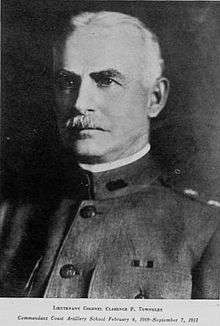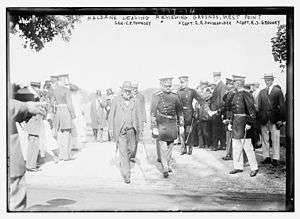Clarence Page Townsley
| Clarence Page Townsley | |
|---|---|
 | |
| Born |
September 24, 1855 De Kalb, New York |
| Died |
December 28, 1926 (aged 71) Washington, D.C. |
| Buried | West Point Cemetery, West Point, New York |
| Allegiance |
|
| Service/ |
|
| Years of service | 1881–1918 |
| Rank |
|
| Unit |
United States Army Field Artillery Branch United States Army Coast Artillery Corps |
| Commands held |
Pensacola Coast Artillery District U.S. Army Coast Artillery School Superintendent of the United States Military Academy 30th Division |
| Battles/wars |
Spanish–American War World War I |
Clarence Page Townsley (September 24, 1855 – December 28, 1926) was a career United States Army officer who became Superintendent of the United States Military Academy.
Early life
Clarence Townsley was born September 24, 1855, at De Kalb, New York, son of Elias P. Townsley and his wife Louise Thompson.[1] Townsley's grandfather Gideon had become postmaster, was elected town supervisor and operated a tannery close to the Oswegatchie River. Townsley's father Elias was also postmaster, was elected De Kalb town supervisor and also to the New York State Assembly.[1]
The younger Townsley was raised in the harsh St. Lawrence County winters in the shadow of the Adirondack Mountains. He attended preparatory school at St. Lawrence Academy in nearby Potsdam,[1] and graduated from Union College in Schenectady, New York in 1876. Townsley spent a year in Sioux City, Iowa working as a civil engineer on the Covington, Columbus and Black Hills Railroad,[2] then was appointed from Iowa to the United States Military Academy at West Point, New York in July 1877, graduating 14th out of 53 in his USMA cadet class.[3]
Military career

On graduation in 1881, Townsley entered the 4th Artillery regiment, and the artillery corps is where he would spend his entire career. After a brief tour in California, Townsley returned to upstate New York, then to several coastal artillery posts. He spent three years teaching drawing at the academy, then back to garrison duty.[3]
During the Spanish–American War, Townsley commanded the Ordnance office of 1st Division, 4th Army Corps in Huntsville, Alabama, and then the Ordnance office for the Department of Havana, Cuba.
In 1905, Major Townsley commanded the Artillery District of Pensacola for a period, then was promoted to lieutenant colonel of the Coast Artillery Corps and was put in command of the Coast Artillery School and the artillery district of Chesapeake Bay in 1909.[4]
Townsley commanded several artillery garrisons before returning to the academy to occupy the superintendent's billet in 1912. Townsley was in command of the USMA during the outbreak of World War I, and continued to serve in this capacity until July 1916, when he was promoted to brigadier general and returned to garrison duty. As the U.S. Army was preparing for entry into the war, Townsley commanded the coastal defenses of the South Atlantic district before brief assignment to Corregidor Island, Philippines, inspecting the formidable artillery emplacements of Manila and Subic Bays.[4]
Recalled to the United States to train and command the 30th Infantry Division (United States), Townsley was promoted to temporary major general before deployment with his command to France. Townsley was in Walter Reed Hospital and on sick leave until just before the Armistice, and then briefly commanded the North Pacific Coast Artillery District. He retired in December 1918.[4]
Notes
References
- Adams, Henry Brooks. Levenson, J.C.; Samuels, Ernest; Vanderslee, Charles; et al., eds. The Letters of Henry Adams, Volumes 4–6, 1892–1918. Harvard University Press. p. 36n. ISBN 0-674-52686-4. Retrieved April 26, 2009.
- Boston University, School of Education. American Education. New York Education Co. p. 163. Retrieved April 26, 2009.
- Clarke, Ida Clyde Gallagher (1918). American Women and the World War. New York: D. Appleton. Retrieved April 26, 2009.
- Colby, Frank Moore (ed.). The New International Year Book. New York: Dood, Mead. p. 755. Retrieved April 26, 2009.
- Cullum, George Washington (1891). Biographical Register of the Officers and Graduates of the United States Military Academy (pdf). 2892. 3 (3rd ed.). Boston and New York: Houghton, Mifflin. p. 346. Retrieved April 26, 2009.
- Cullum, George Washington (1920). Robinson, Wirt, ed. Biographical Register of the Officers and Graduates of the United States Military Academy...: Supplement (1910–1920). 2892. VI–A. Edward Singleton Holden, Charles Braden (3 ed.). Saginaw, Michigan: Houghton Mifflin. p. 313. Retrieved April 26, 2009.
- Curtis, Gates, ed. (1894). "Chapter 28: The Town of De Kalb". Our County and Its People, A Memorial Record of St. Lawrence County, New York. Boston, Massachusetts: The Boston History Company.
- Delta Upsilon fraternity (1902). Dodge, Melvin Gilbert, ed. The Delta Upsilon Decennial Catalogue. Ann Arbor, Michigan: Richmond & Backus. p. 202. Retrieved April 26, 2009.
- Leonard, John W. (1909). Who's who in New York City and State. 4 (4 ed.). New York: L.R. Hammersley. p. 1292. Retrieved April 29, 2009.
- National Society of the Colonial Dames of America in the State of Connecticut (1907). Register of the Connecticut Society of the Colonial Dames of America, 1893-1907. The Connecticut Society. p. 167. Retrieved April 26, 2009.
| Military offices | ||
|---|---|---|
| Preceded by Thomas Henry Barry |
Superintendents of the United States Military Academy 1912–1916 |
Succeeded by John Biddle |